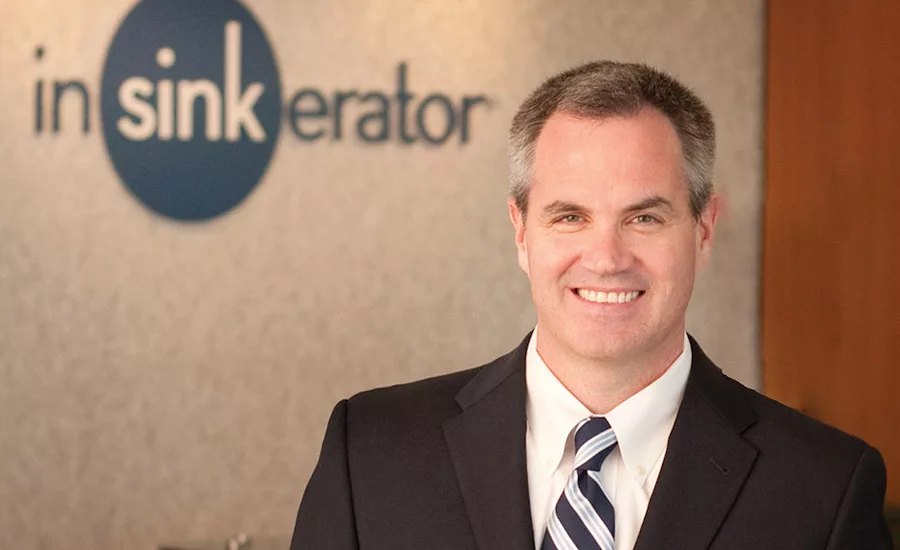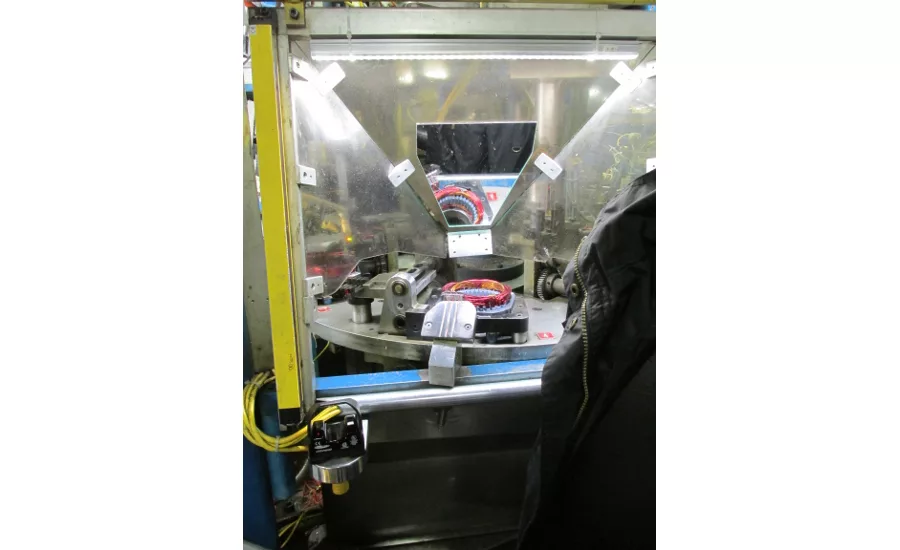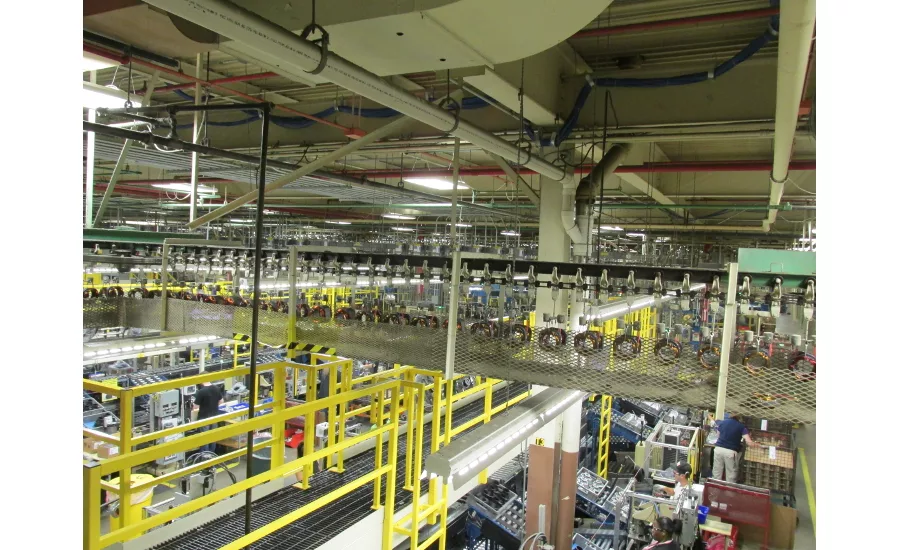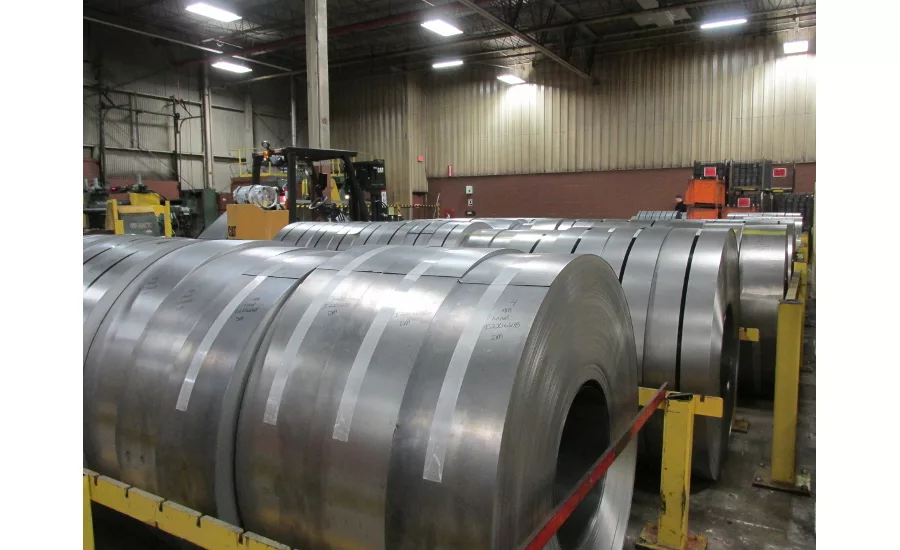PM Profile: InSinkErator President Tim Ferry
InSinkErator highlights environmental benefits of food waste disposers.

InSinkErator President Tim Ferry, who joined the company in 2011 as its president. Photo credit: InSinkErator

InSinkErator makes the motors for its food waste disposers in-house. Here the wiring is placed within the motor assembly. Photo credit: Kelly Faloon/Plumbing & Mechanical

Line workers at InSinkErator’s Racine, Wis., manufacturing facility. InSinkErator is the only U.S. manufacturer of food disposers, which it believes is a competitive advantage since many consumers are looking for products made in the United States. Photo credit: Kelly Faloon/Plumbing & Mechanical

InSinkErator manufacturers its Badger line at the Racine, Wis., manufacturing facility (pictured) while the Evolution line is made in Kenosha, Wis. Photo credit: Kelly Faloon/Plumbing & Mechanical

Rolls of steel at InSinkErator’s Racine, Wis., plant. The company makes almost every part of its disposers in-house, from the steel casing to the impellers. Photo credit: Kelly Faloon/Plumbing & Mechanical
Plumbing & Mechanical interviewed InSinkErator President Tim Ferry at the company’s headquarters in Racine, Wis., last fall. A manufacturer of food waste disposers and hot water dispensers, InSinkErator is a business unit of Emerson Electric Co. Ferry joined InSinkErator in 2011 as its president. Prior to InSinkErator, he was president of Emerson Tool Co. With more than 27 years of experience at Emerson, Ferry has served in a variety of management capacities including sales, marketing and as a divisional general manager.
PM:What are the advantages to having a food waste disposer in a residence or business?
TF:The primary advantage is convenience, followed by hygienic benefits. I grew up with one and can’t imagine not having one to take care of all the scraps from the food prep we do. I have five kids, and when they were younger and had a bowl of cereal, they took two bites and were off to school. What do you do with leftover cereal?
Wet waste in particular can be a problem when you put it in the garbage. During certain times of the year when weather hinders garbage pickup, you’ve got smelly waste that’s sitting in your garbage can, attracting bugs and pests. In urban areas, that may mean rats and mice; in rural areas it could be raccoons or bears.
We’re now starting to communicate to the public about the environmental benefits of garbage disposers — the diversion of organics from landfills. The food waste is processed through the wastewater treatment facility, which is clearly an environmental benefit. When food is thrown away in the garbage can, it ends up in a landfill, where it creates methane, a very potent greenhouse gas.
PM:What are the common mistakes people make when using food waste disposers?
TF:Around Thanksgiving we get a lot of calls, and the majority of them deal with food blockage and jamming. After peeling five or 10 pounds of potatoes, rather than continuously feeding the peels into the disposer, they put all the peels in at once. If you feed the disposer on a constant basis instead of pushing a lot of food in at one time, and run some water down the drain at the same time, then you’ll have no problems.
People still have a lot of misconceptions about the type of food scraps they can put in a garbage disposer. They’re fearful about putting in chicken bones or celery because they think it’s going to cause problems downstream. But InSinkErator models are very robust. The only food waste we’ve found that an Evolution Series disposer can’t grind up is raw shark skin; it’s very rubbery. And one could argue whether it’s actually food.
PM:Why should consumers use a plumbing professional to install a disposer?
TF:Whether it’s a new installation or a replacement, we recommend people have a plumber install their InSinkErator disposal. It’s a product that lasts 10 years or longer typically, and a plumber will make sure the disposer is installed correctly. It gives people peace of mind.
PM:What are the latest trends in disposers, residential and commercial?
TF:On the residential side, we continue to make sure we have quiet systems. Our Evolution Series is the quietest disposer in the market. We continue to look at the technology from a grinding capability and the fineness of grinds so homeowners don’t have downstream issues. We have anti-jam circuits in our Evolution Series that recognize and prevent a potential jam before it happens.
On the commercial side, we have a new business entity we’re calling Grind to Energy. There are a lot of regulatory headwinds as it relates to diversion of food waste for institutional and commercial locations. The Grind to Energy system will grind up the waste from supermarkets, casinos, hotels — places that have a lot of waste — in one of our 10 hp units, and the slurry is piped into a holding tank, bypassing the sewer infrastructure. The slurry in the tank is transported to an anaerobic digestion facility where the methane gas is then converted to renewable energy in the form of either heat generation back to the facility or, if it has enough capacity, electricity through a generator.
This is a big trend. Many states prevent the disposal of food waste into landfills and we’re presenting a solution that’s attracting attention, espcially in larger commercial institutions. We have units in Whole Foods, Sendik’s stores in the Milwaukee area, and Roundy’s/Mariano’s stores in the Chicago area.
PM:Is there a benefit for large municipalities to encourage people to use food disposers?
TF:The large systems are not practical for residential uses; the most efficient waste system is the still the sewer infrastructure. Those wastewater treatment plants with advanced facilities have anaerobic digestion. Food scraps have more carbon content than human waste, therefore they have more energy potential. So food scraps that go through a wastewater treatment facility create more methane, which is a renewable energy benefit. Chicago’s Stickney Water Reclamation Plant, one of the largest treatment plants in the world, uses anaerobic digestion to create renewable energy. Boston’s Deer Island Sewage Treatment Plant is said to sell energy back to the grid.
Food waste is a feed stock for renewable energy through advanced wastewater treatment plants that have anaerobic digesters. In fact, the city of Milwaukee encourages the use of food waste disposers because of the energy potential.
Wastewater treatment plants, from a biosolids perspective, process the waste and what’s leftover is used for fertilizer. It’s pretty cool when you step back and think about the fact there’s energy in food scraps. How do we harvest that energy instead of sending it to a landfill, creating greenhouse gases and causing environmental issues? We’ve partnered with five cities — Boston, Chicago, Philadelphia, Milwaukee and Tacoma, Wash. — to prove to them that food disposers can help them manage their municipal solid waste. You can view a video on our YouTube page that talks about the Phildelphia pilot project [https://www.youtube.com/watch?v=v8B91puL4IM].
Our issue is trying to get people to use their disposers more, to overcome these misconceptions that they can’t throw certain food types in. But they can, and it’s a potential energy source.
PM:Are food disposers a growing market?
TF:The food disposer market is growing. As we circulate the environmental benefit message, it’s resonating more clearly with consumers and large municipalities. InSinkErator has been in this business for a while, so we’re the stewards of this initiative.
PM:What are the advantages of a hot water dispenser?
TF:It’s another product that, once you have one, you can’t imagine not having one. It’s convenient; if you want to make instant soup, ramen noodles or tea, hot water is instantly accessible and the food is ready to eat. You don’t have to heat something up in the microwave or on the stove. It’s also great for baby formula.
Hot water dispensers have a multitude of uses, such as cleaning. Our marketing literature says there are 101 uses for them, but people keep discovering more.
PM:With the high prices of some bottled waters, are filtration faucets becoming more or less popular?
TF:Dispensers and faucets offering filtration are gaining popularity because water quality is an issue in many areas of the country, particularly those with hard water. The EPA monitors municipal drinking water but many U.S. households are on private wells, which are not under strict regulatory control. Chemicals such as chlorine are added to public water supplies and can adversely affect taste and odor.
In-home filtration is an alternative and costs many times less than bottled water, while ensuring the best-tasting water for drinking and cooking and the safest water for both. While popular in private residences, our products also are used in commercial applications, including one well-known coffee purveyor with thousands of locations worldwide.
PM:How important is InSinkErator’s relationship with plumbing distributors?
TF:The relationship is critical. Plumbers form the backbone of the company. We made the distribution choice to go through plumbing wholesalers because of it. A lot of our competitors went the appliance route, from a distribution standpoint. We’ll continue to build on those distributor relationships we’ve built over the last 77 years. Working with plumbers and plumbing wholesalers, enhancing their businesses, is key to InSinkErator’s future growth.
PM:How does InSinkErator’s “Made in the USA” campaign benefit the company?
TF:InSinkErator is the only U.S. manufacturer of food disposers, as well as the only North American manufacturer. We’ve been that way from day one. We did have a U.S. competitor years ago that moved to China. But we’ve stayed here — we have a great workforce in southeast Wisconsin. We’re vertically integrated, so we have a big supply base close to us.
The important aspect is we are closer to our customer and are able to handle demand fluctuations. We want to be local in terms of manufacturing. We think it’s a competitive advantage in the marketplace because consumers are looking for products made in the United States — as long as the value is there. And we believe InSinkErator provides that value as well as performance.
It’s also a highly valued attribute when our products are sold in other parts of the world.
PM:What can plumbing professionals expect to see from InSinkErator in 2016?
TF:We’re constantly looking at new products and new ideas. We have a new 3-in-1 hot water system that’s an integrated kitchen faucet. We introduced it in Europe in early 2015 and will be introducing it in North America this year.
We’re continuing to evolve on the disposer side with new technology and innovation. Part of our DNA here is a strong research and development department to maintain our leadership position in the market. We have tremendous engineering and research lab capabilities so we can continue to innovate and have the best disposers on the market. We leverage our “Made in the USA” factory as part of it.
PM:What excites you about InSinkErator?
TF:The people. They are so passionate about building and selling the best disposers — sales, marketing, engineering or manufacturing. Generations of people have worked here over the past 77 years. We’ve made more than 150 million disposers, which is remarkable. So what has resonated with me in my 4 1/2 years at InSinkErator is the passion our workforce has to make, design and market the best products in the world.
We’re big on innovation and doing the right thing for our customers. We’re very customer-focused — delivery, quality, post-sales service — making sure we take care of the end users in the most efficient and timely manner, and that they’re satisfied. It’s the culture of the business. We’re the market leader for a reason, and it all starts with having the right people.
Looking for a reprint of this article?
From high-res PDFs to custom plaques, order your copy today!



